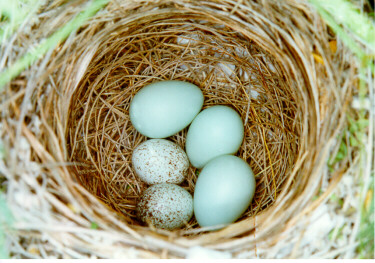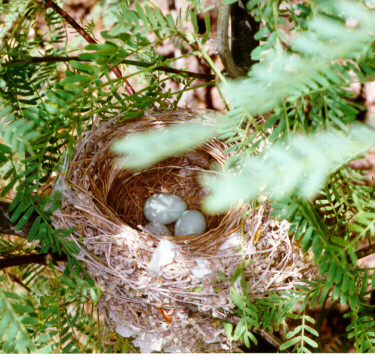Blue Grosbeak Nest With Eggs Photograph and Sound Recording
Photo by Greg Clark, May, 1998
 The Blue Grosbeak is a late nester compared with most birds in the sonoran desert regions of Arizona. Only the Yellow-billed Cuckoo, and the grasslands sparrows that nest in association with the moonsoon rains of summer, nest later in the desert than the Blue Grosbeak. The nest photographs on this page were taken near the Gila Box on the Gila River west of Clifton, Arizona at the very end of May. Some desert species have already fledged one nest by this date and are working on their second. The eggs are a pale blue color and are unmarked. Perhaps you have figured out what the other two eggs are by now. The Brown-headed Cowbird will lay its eggs in a wide variety of nests of other birds. In this case it is the unfortunate Blue Grosbeak that will be raising the cowbird's young. Some species of birds make poor hosts for cowbirds because the incubation time is so low. This would seem to be the case for the Blue Grosbeak. Its incubation period is only 11-12 days (about the same as the cowbird) unlike the 14 days of favorite host targets like the Bell's Vireo. The Brown-headed Cowbird baby usually hatches one day ahead of the host's first egg. If the host's incubation time is two days shorter it removes some of the advantage of the cowbird survival strategy. Even so, the huge number of eggs laid by a cowbird in a year guarantee its survival even if only 2 out of the 40 eggs laid in a single breeding season produce adults. Since the success rate appears to be better than this, the cowbird population is growing rapidly.
The Blue Grosbeak is a late nester compared with most birds in the sonoran desert regions of Arizona. Only the Yellow-billed Cuckoo, and the grasslands sparrows that nest in association with the moonsoon rains of summer, nest later in the desert than the Blue Grosbeak. The nest photographs on this page were taken near the Gila Box on the Gila River west of Clifton, Arizona at the very end of May. Some desert species have already fledged one nest by this date and are working on their second. The eggs are a pale blue color and are unmarked. Perhaps you have figured out what the other two eggs are by now. The Brown-headed Cowbird will lay its eggs in a wide variety of nests of other birds. In this case it is the unfortunate Blue Grosbeak that will be raising the cowbird's young. Some species of birds make poor hosts for cowbirds because the incubation time is so low. This would seem to be the case for the Blue Grosbeak. Its incubation period is only 11-12 days (about the same as the cowbird) unlike the 14 days of favorite host targets like the Bell's Vireo. The Brown-headed Cowbird baby usually hatches one day ahead of the host's first egg. If the host's incubation time is two days shorter it removes some of the advantage of the cowbird survival strategy. Even so, the huge number of eggs laid by a cowbird in a year guarantee its survival even if only 2 out of the 40 eggs laid in a single breeding season produce adults. Since the success rate appears to be better than this, the cowbird population is growing rapidly.
 Additional view of the same nest located near the Gila Box on the Gila River in Arizona. May, 1998
Additional view of the same nest located near the Gila Box on the Gila River in Arizona. May, 1998
Photo by Greg Clark
The original Blue Grosbeak sound recording was produced using a Sennheiser MKH70 shotgun microphone and the audio was stored on a 48 ksps DAT using a Tascam DA-P1 digital audio recorder. The recording was down-sampled to 44.1 ksps and converted to MPEG3 to reduce the file size to 446k bytes. The distance from the microphone to the bird is about 30 feet. The gaps between song sections were removed to shorten the download time. The gaps are typically around 8 seconds long, much longer than the gaps you will hear on this recording. Other than the gap removal, no other editing or filtering has been performed.
download mpeg3 recording (blue_gb.mp3)
Copyright Greg Clark, 1999
update 8/2012